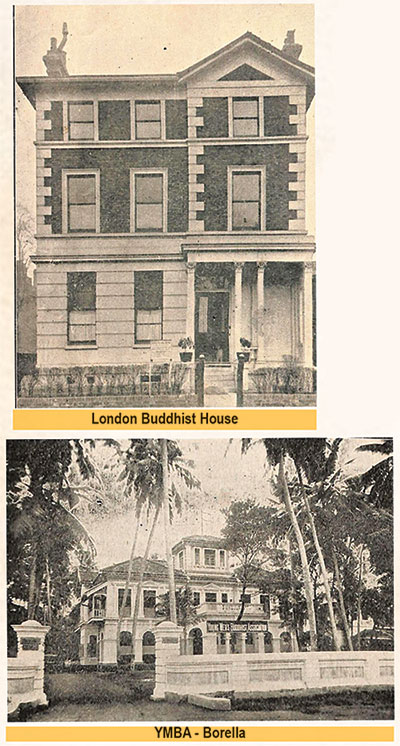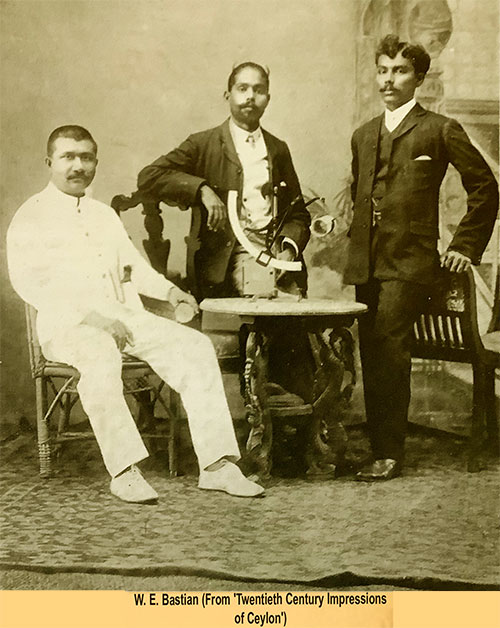Preaching in print: The Buddhist journal in the Buddhist Revival
By Uditha Devapriya
Archive images courtesy of the J. R. Jayewardene Centre
The role of the journal in the Buddhist Revival in British Ceylon has never been seriously examined by scholars. Most historical accounts trace the origins of a Buddhist press to the late Dutch and early British periods. The growth of print capitalism held certain implications for the Buddhist backlash against Christian evangelism, as it did in other colonial societies. Yet the momentum of this backlash was never the same: it responded to changing economic and social conditions, and followed a logic and a pattern of its own.
The Buddhists who took over the task of disseminating propaganda against their ideological foes had to fall back on the same institutions that those foes had had recourse to. In 1855 the first Buddhist press was founded from an establishment which had, for three decades, belonged to the Church Missionaries in Kotte. We are told that a second press was set up in Galle a few years later, through the patronage of King Mongkut of Siam and an influential Kandyan chief. These developments spurred monks like Migetuwatte Gunananda Thera to play a leading role in the Christian-Buddhist debates of that period.
The Buddhist press, as it stood at this juncture, was not a little rudimentary. But compared to the meagre resources it had to put up with, it mobilised a rather impressive campaign against its opponents, ironically using the very weapons the latter were using against it. In 1862 Gunananda Thera took the initiative of establishing a Society for the Propagation of Buddhism. Kitsiri Malalgoda has observed that the organisation modelled itself along the lines of the Society for the Propagation of the Gospel. Over the next few years it published a number of important tracts, many of them written by Gunananda Thera and Hikkaduwe Sri Sumangala Thera, which would form the basis of the Buddhist Revival.
These tracts were published in response to an ever-swelling morass of anti-Buddhist publications, particularly those authored by preachers like Daniel Gogerly. Historians have focused on such publications and given them due emphasis. They have noted that they had a significant impact on the Buddhist Revival, bringing the confrontations between Buddhist monks and Protestant preachers to the notice of Western Theosophists like Colonel Olcott and Madame Blavatsky. What is often missing in these historical evaluations is the way the Buddhist press changed with the arrival of the Theosophists, indeed how both the form and content of these publications altered in light of two key developments: Western, specifically European, interest in Buddhism, and the rise of a Sinhala petty bourgeoisie.
 In my view, the role of Western patronage during the Buddhist Revival depended on two factors: the prominent part played by the Theosophists and [paradoxically] their flickering fortunes in the face of an assertive, anti-Theosophist Revival, the latter spearheaded by firebrands like Anagarika Dharmapala; and the conversion to [Theravada] Buddhism of several middle-class Europeans in British Ceylon and Burma. These took Buddhism, as it stood in South and South-East Asia, beyond a Theosophist frame. They also emboldened a fiercely nationalist and anti-imperialist middle-class – or petty bourgeoisie – to take up the leadership of the movement, while partnering with Theosophists and Orientalists who had poured much energy and initiative into the Revival in its early years.
In my view, the role of Western patronage during the Buddhist Revival depended on two factors: the prominent part played by the Theosophists and [paradoxically] their flickering fortunes in the face of an assertive, anti-Theosophist Revival, the latter spearheaded by firebrands like Anagarika Dharmapala; and the conversion to [Theravada] Buddhism of several middle-class Europeans in British Ceylon and Burma. These took Buddhism, as it stood in South and South-East Asia, beyond a Theosophist frame. They also emboldened a fiercely nationalist and anti-imperialist middle-class – or petty bourgeoisie – to take up the leadership of the movement, while partnering with Theosophists and Orientalists who had poured much energy and initiative into the Revival in its early years.
When describing the Sinhala petty bourgeoisie, formed of traders and professionals hemmed in by colonial structures, as anti-imperialist and nationalist, it must be noted that their vision of anti-imperialism and nationalism was necessarily limited, if not insular. Their formation was essentially linked to the spurt in economic activity which accompanied the Colebrooke-Cameron era. The emergence of a plantation bourgeoisie eventually led to the formation of certain ancillary sectors, particularly in the import of foreign merchandise. The Sinhala petty bourgeoisie filled this gap, to some extent. Yet in doing so, it had to pit itself against other ethnic [minority] groups, both local and foreign, which had the upper hand in these activities by virtue of their access to credit and banking facilities.
These were the twin imperatives which determined their ideology: their dependence on subsidiary sectors that in turn were linked to a thriving import sector, and their competition with other ethnic groups. Soon they took the lead in sponsoring, if not funding, a number of important initiatives linked to the Revival, such as the construction of a Pilgrims’ Rest House at Anuradhapura. Naturally enough, they made up the crust of the Sinhala intelligentsia. In combating the influence of other ethnic groups, they eventually fell back on the institutions that had enabled the Buddhist Revival to take off. It was at this juncture that Sinhala traders began lavishly pouring in funds to the publication of new journals, breathing new life to such initiatives in a bid to rechart the contours of the Revival.
As far as their attitude to colonialism was concerned, the Sinhalese traders were as Janus-faced as their ancestors. Despite certain limits and constraints, they had benefitted from the colonial economy. They had turned their attention to the religious dimension of colonial rule, basing their critique of imperialism on the monopoly over education, marriage, and other aspects of civilian life exerted by missionaries. The need to preserve Buddhism, and to restore it to some “antebellum” past, was hence articulated almost purely in cultural terms. This was to be expected: not even after the 1915 riots, a turning point in the Revival, did the most ardent nationalist imagine a Ceylon falling outside the orbit of British rule.
In contrast to their forebearers, whose programme for the revival of Buddhism was limited to the country, these new financiers and patrons imagined a Buddhist world beyond Ceylon. Accordingly, they sought to publish journals and magazines which bridged the gap between the home and the world, reinforcing linkages between Buddhist countries: the repositories of the faith in the Orient on the one hand, and the emerging networks of Buddhist temples and societies in the Occident on the other. They were helped in this by the wealth they had earned from their participation, as bystanders, in the plantation economy.
By its nature, print is both subversive and conservative. The Christian press had used it to advocate the continuation of the status quo; the Buddhist press had used it to advocate a transformation of that status quo. Yet through the press the revivalists sought not so much a radical change in society as a reversal to, and restoration of, an imagined pristine past. In this they were following a tradition begun by the first anti-British insurrectionists, who while opposing British rule clamoured for a restoration of the Kandyan kingdom.
The new patrons of the Buddhist press reinforced this message. If at all, their wealth made them less amenable to revolutionary and radical politics: all they wanted was to exhibit or showcase the “superiority” of their faith. For their part, authorities did not oppose these groups, except when they their activities clashed with the aims of the colonial government. Indeed, they went as far as to praise the Sinhala petty bourgeoisie: here, for instance, is the entry on a wealthy Sinhala trader in Twentieth Century Impressions of Ceylon:
 “Mr. W. E. Bastian was born in Colombo in 1876, and, after receiving his education at the Ananda College, in his native city, joined a local mercantile firm of paper-merchants in the capacity of manager, which post he held for a number of years and relinquished only to set up in business on his own account. The rapid growth of the present business under his management, within the short period it has existed, is an indication of his capacity and integrity. Mr. Bastian is a Buddhist by religion, and enjoys an important standing in his community.” [Twentieth Century Impressions of Ceylon, page 482]
“Mr. W. E. Bastian was born in Colombo in 1876, and, after receiving his education at the Ananda College, in his native city, joined a local mercantile firm of paper-merchants in the capacity of manager, which post he held for a number of years and relinquished only to set up in business on his own account. The rapid growth of the present business under his management, within the short period it has existed, is an indication of his capacity and integrity. Mr. Bastian is a Buddhist by religion, and enjoys an important standing in his community.” [Twentieth Century Impressions of Ceylon, page 482]
We have reason to believe that these biographical sketches were written by their very subjects. Nevertheless, that a major colonial work on the geography, economy, politics, and personalities of British Ceylon should feature a Sinhala trader so prominently, allowing him to wax eloquent on his own worth, tells us much about the authorities’ tolerance, indeed encouragement, of such individuals. My argument, basically, is that this is what helped the Sinhala petty bourgeoisie to carry on their campaign for “the preservation of the faith”, and what made them couch the latter objective in terms of cultural polemics, rather than a full-frontal political critique and condemnation of British colonialism per se.
We would do well to recognise the limits of the Sinhala petty bourgeoisie. Through journals like The Buddhist Annual of Ceylon – perhaps the most important such publication from the early 20th century – the revivalists sought nothing less, and nothing more, than a chance to prove the intrinsic worth of their faith. The failure of this revivalist tendency to transition to a full, total critique of colonialism must, in that respect, boil down to what Regi Siriwardena described as the weak and embryonic nature of the Sinhala middle-class: a quality which at once pushed them against other ethnic [foreign and minority] groups, while hindering them from organising a progressive anti-imperialist movement.
The writer is an international relations analyst, researcher, and columnist who can be reached at udakdev1@gmail.com



